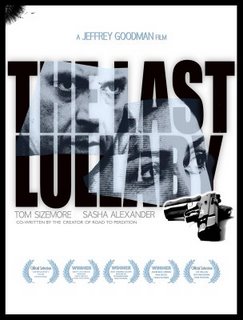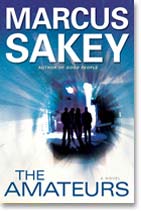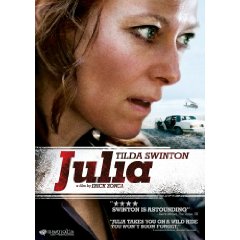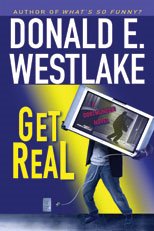DVD: The Last Lullaby (2008) The Last Lullaby is a throwback, deliberately so. It’s a taut, low-key crime drama, more interested in character than chaos, with the feel of a Gold Medal paperback. That may be to its financial detriment; the filmmakers ultimately distributed the movie themselves after a long run on the festival circuit. An upcoming DVD release should allow Lullaby to find its audience.
The Last Lullaby is a throwback, deliberately so. It’s a taut, low-key crime drama, more interested in character than chaos, with the feel of a Gold Medal paperback. That may be to its financial detriment; the filmmakers ultimately distributed the movie themselves after a long run on the festival circuit. An upcoming DVD release should allow Lullaby to find its audience.
Max Allan Collins co-wrote the movie, based on his short story “A Matter of Principal.” Tom Sizemore plays a hit man settled into uneasy retirement who finds himself drawn back into the life, only to experience complicated feelings for the woman he’s meant to kill.
Lullaby benefits from its deliberate pace. That’s not to say that it’s slow, but that it’s set in a world where actions have consequences and the movie has the confidence to allow them to play out. Sizemore gives a revelatory performance as a genuine tough guy who knows he doesn’t need to shout in order to make himself heard, and there’s a delicacy to his scenes with his target (Sasha Alexander). Lullaby could also be eligible as the Best Foreign Film entry from America, a nation of highways and chain restaurants, of small towns with their own rhythms. There’s a scene where Sizemore’s character meets the man who hires him at his lake house. It’s not Hollywood’s idea of a big spread, but in plenty of places it’s exactly what a rich man’s digs look like.
Lullaby’s director Jeffrey Goodman has been chronicling the film’s release at Moviemaker magazine.
Sunday, August 30, 2009
Monday, August 24, 2009
Miscellaneous: San Francisco Treats
Back from a long weekend in San Francisco, my home away from home (Seattle) away from home (New York). Good friends, good conversation and good cocktails abounded.Among the highlights was a visit to Mission Dolores, part of an ongoing pilgrimage to the locations used in Alfred Hitchcock’s Vertigo. Alas, it wasn’t open. But I have it on good authority that Carlotta Valdes isn’t buried there anyway.
We spent an entire day at SFMOMA, which currently has some extraordinary exhibits. Georgia O’Keeffe and Ansel Adams: Natural Affinities does what every museum show should, which is make you see an artist or in this case two of them in a new way. Running concurrently is an extensive display of photographs by Richard Avedon. Plus there’s SFMOMA’s impressive permanent collection and the new rooftop sculpture garden. It’s one of my favorite museums.Also stopped in at the Museum of Performance and Design’s tribute to Noël Coward. Personal papers and photographs galore, not to mention dressing gown after dressing gown after dressing gown. I’ve always admired Coward, but after seeing this exhibit he’s now one of my heroes. He came from nothing and transformed himself into the epitome of international style and sophistication by cultivating that image. He lived the life he wanted by living the life he wanted. There’s a lesson there. Some choices quotations from the man: “I can’t sing, but I know how to, which is quite different.” And, “The only way to enjoy life is to work. Work is much more fun than fun.” Speaking of which, I’d better get back to it.
Thursday, August 20, 2009
Sort Of Related: The Amateurs, by Marcus Sakey (2009)/Julia (U.S. 2009) The latest novel by Marcus Sakey nails that stage in life when potential begins to curdle into disappointment. Four Chicago friends meet regularly for drinks every week. All of them unattached, in their 30s, and wondering what happened to the fabulous lives they were going to lead. When one of them is pulled by his boss against his will into a drug deal, they decide to steal the money for themselves. But the job doesn’t go as planned. The foursome may not be as close as they thought. And what they’ve stumbled into is no ordinary drug deal.
The latest novel by Marcus Sakey nails that stage in life when potential begins to curdle into disappointment. Four Chicago friends meet regularly for drinks every week. All of them unattached, in their 30s, and wondering what happened to the fabulous lives they were going to lead. When one of them is pulled by his boss against his will into a drug deal, they decide to steal the money for themselves. But the job doesn’t go as planned. The foursome may not be as close as they thought. And what they’ve stumbled into is no ordinary drug deal.
The lead characters are drawn with plenty of shading and rough edges. There are sharp observations about friendship and aging. A passage early on sets the tone, when the sole female member of the group talks about how going out on Saturday night once meant feelings of lightness and possibility. Now she fills days and waits to turn into her mother. The Amateurs also captures the mood of those months in 2008 when Americans felt impotent collective rage at the collapse of the financial system and the associated lack of accountability. A strong piece of work.
Speaking of people who should not undertake lives of crime ...
(You see? There are themes to these entries.)
Julia played the festival circuit, received an abbreviated theatrical release, and is out this week on a bare bones DVD. It’s a two-and-a-half-hour character study-cum-crime drama. And it demands your immediate attention.
Tilda Swinton plays the title role, a self-destructive L.A. alcoholic blazing her own path to hell. At an AA meeting she meets a fellow sufferer who presents her with a deranged plan: kidnap my son from his wealthy grandfather. Julia, at the end of her long, unraveling rope, goes along with it. The crime in this movie is not that of big-budget thrillers or gritty noir novels that tout their realism. This madness is right out of a police blotter, caprice and coincidence colliding with bad planning and poor impulse control. Harrowing.
The crime in this movie is not that of big-budget thrillers or gritty noir novels that tout their realism. This madness is right out of a police blotter, caprice and coincidence colliding with bad planning and poor impulse control. Harrowing.
Julia is also one of the great depictions of a hardcore drunk. The character is always ready with blame and an excuse. Her highs are believably high, her lows degrading. Swinton is simply astonishing, serving up the addict’s quicksilver shifts from confidence to rage to petulance. It’s a titanic performance.
The movie is a messy ramble, at times maddening but always fascinating. That’s only fitting for a film inspired by John Cassavetes and specifically Gloria. How odd is it that for all Cassavetes’ influence it’s a movie he tossed off as a lark that has spawned remakes official and unofficial?
Sunday, August 16, 2009
Miscellaneous: Whip Round #1
Many projects moving forward at once, so expect more posts like this. Alighting on multiple topics with no diminution of my customary acuity.
The Girl Who Played With Fire, by Stieg Larsson (2009). I was not the only one who fell hard for Larsson’s debut, last year’s The Girl With The Dragon Tattoo. Which makes this follow-up so disappointing. Larsson’s old-fashioned style suited the first book, essentially a locked-room mystery set on an island. Without that setting, Larsson’s voice simply seems plodding. (Bad news is delivered by the cops. “Berger’s mouth dropped open. Blomkvist looked as if he had been struck by lightning.”) I read all 500 pages, shopping lists and trips to Ikea included, for one reason: Larsson’s beguiling creation Lisbeth Salander, a sort of real-world version of William Gibson’s Molly forged by cruelty and institutional neglect. I’ll tackle the last entry in the series for that reason, too.
The Shimmer, by David Morrell (2009). Morrell uses the mysterious Marfa lights as the basis for a conspiracy thriller. He shrewdly reinvents Marfa as Rostov, Texas, even fictionalizing the filming of Giant in the town. The only thing missing is an alternate reality Donald Judd. But for all Morrell’s skill at creating tension, it’s the human moments that register most strongly. When New Mexico cop Dan Page discovers the reason why his wife fled their home to visit the lights, there’s no supernatural explanation. Just pure heartbreak.
Julie & Julia (2009). Somebody has to admit it, so I will: I enjoyed the Amy Adams scenes. I enjoyed the whole thing.
College Swing (1938)/Back to School (1986). I read an interview with David Letterman years ago in which he cited Bob Hope as an example of someone who, perhaps, stayed too long at the fair. Watching his early film College Swing, I understood what Dave meant. Hope’s hustling coward character still feels unbelievably fresh and modern. The script, an excuse to link together songs and novelty acts, gets some zing from an uncredited Preston Sturges. Gracie Allen has some great moments, and there’s a Jerry Colonna bit that’s priceless. Also with a fully-haired Jackie Coogan cutting a rug with then-wife Betty Grable. A few days later I stumbled onto Back To School, which uses several of the same plot elements. Featuring New Wave Robert Downey, Junior and his future director Keith Gordon. God, I miss Rodney Dangerfield.
Tuesday, August 11, 2009
Movie: The Carey Treatment (1972)
Michael Crichton wrote novels to put himself through Harvard Med. Because really, what else did he have to do? I’m sure he also had a paper route. This not-on-DVD adaptation of Crichton’s Edgar Award winner A Case of Need, published under the pseudonym Jeffery Hudson, aired on TCM. The draw for me was the fact that it was directed by Peter Gunn guru Blake Edwards.
James Coburn plays a rock star pathologist recently arrived in Boston. When his friend (character actor James Hong in what may be the most solid part he’s ever had) is charged with killing the daughter of the chief of surgery during an abortion, Coburn launches his own investigation. It’s CSI: House in the swinging ‘70s, with a jazz score by Roy Budd (Get Carter). Director Edwards was not happy with the final version; neither were the screenwriters who took their names off the movie. Crichton’s plot still works when the movie remembers it, but there are too many suede jacketed “let’s just be, baby” scenes. Which, to be fair, do add to the overall entertainment value. For that matter, so does a kinky massage interrogation between Coburn and former Beyond The Valley of the Dolls star/future Turner & Hooch screenwriter Michael Blodgett.
Coburn can be a strange presence, as Steve Lewis observed last week. I wouldn’t go as far as Steve, but I do see his point. Coburn often manages to come across as simultaneously cool yet insubstantial. When I watch one of his movies I’m reminded of the line from The Limey when Peter Fonda is told he’s not so much a person as a vibe. That’s true in spades here. But sometimes a vibe is all you need.
Sunday, August 09, 2009
Passings: Budd Schulberg and John Hughes
It’s facile to compare the lives of two people who die within days of each other. Individuals whose names would ordinarily never be spoken in the same sentence are irrevocably joined. They’re linked only through quirks of fate and the calendar, yet the mind can’t help making connections, drawing parallels.
Budd Schulberg died on Wednesday after a full life at the age of 95. His legacy includes What Makes Sammy Run, one of the essential Hollywood novels. On the Waterfront, which he wrote, remains both a gripping drama and a maddening artifact of a troubled American era. (Schulberg testified voluntarily before HUAC and named others working in Hollywood who had been members of the Communist party in the 1930s.) A Face in the Crowd, with its homespun media demagogue, has lost none of its prophetic power. Schulberg’s long tenure as a boxing correspondent yielded the novel (and eventually the film) The Harder They Fall.
John Hughes died on Thursday, too young at age 59. He had largely retreated from filmmaking. Every few years there would be a swirl of rumors that he’d return to directing, and I always hoped he would.
I was a teenager during Hughes’s glory years in the 1980s, so you’d think that his movies meant the world to me. You’d be wrong. I still haven’t seen Sixteen Candles in its entirety. My first exposure to The Breakfast Club was on VHS at a friend’s “movie party.” I didn’t succumb to Ferris Bueller’s Day Off until late in its run. I actively resisted the Hughes oeuvre at the time. I didn’t need movies about adolescent misery by some pandering adult; I was living it. (I was a pretentious little ass in those days. I’m a pretentious big ass now.) It’s a tribute to Hughes’ particular genius that my blind impulse for self-preservation is one he would have readily understood.
The Breakfast Club may be glib, but its depiction of high school is unerring. We cling to our labels even as we long to shed them. Bueller is Hughes’ greatest achievement, a daft charmer about the porous boundary between youth and adulthood. You can worry to excess as a kid – it will surprise no one to learn that Alan Ruck’s Cameron was the first movie character I ever truly identified with – and you can forget as a grown-up that taking time for yourself is easy and vital. The Vacation movies, or the first and third ones at any rate, expose the truth that parents are slaves to expectation as much as their offspring are. They’re also funny as hell.
It’s unfair to knock Hughes for the narrow focus of his films. Life got small before the pictures did. Schulberg wrote about the wider world, about the complex systems of institutions and the demands they make on individuals, because he could. Hughes took as his subject the everyday woes of white suburban teenagers and the white suburban parents they became, because by the 1980s that was all audiences cared about. (I warned you upfront that these comparisons would be facile.) Each man engaged with the issues of his day and thus helped to define his era. I bow my head to mourn them, as well as a time when movies were more interesting.
Read Schulberg’s essay on his experience of working with F. Scott Fitzgerald. Thanks to Ed Gorman. Also read about Hughes’ uncommon generosity to a young fan.
Wednesday, August 05, 2009
On The Web: Ed Gorman
Ed says far too many fine things about the Noir City Sentinel. Such as, “I’ve never read a book on noir that was as informative and just as much as downright fun” as the latest issue.
Go read it for yourself. Then kick in a few bucks to the Film Noir Foundation and have the goodness delivered straight to your inbox.
Speaking of noir ...
DVR Alert: Glenn Ford
As part of their Summer Under the Stars festival, Turner Classic Movies is dedicating this Friday, August 7, to the films of Glenn Ford. Gilda understandably gets pride of place, with the original 3:10 to Yuma not far behind. (One of Ford’s best known noirs, The Big Heat, will air on August 13 as part of Gloria Grahame Day.) Among the lesser known Ford films are two that I can heartily recommend.
The first is Framed (1947), airing at 4:45PM EST/1:45PM PST. I saw this one at Noir City. Take advantage of this rare opportunity to enjoy Janis Carter, all legs and cheekbones and wildly darting eyes, in her I’m-gonna-say glory.
The other is 1949’s The Undercover Man (10PM EST/7PM PST). TCM ran this neglected film for the first time last month, and I’m glad they’ve got it on the schedule again already. Expert noir hand Joseph H. Lewis (Gun Crazy, The Big Combo) directs this account of Treasury agents scrambling to take down Al Capone, referred to throughout the film solely as “the Big Fellow.” Featuring a dandy performance by Barry Kelley as a Mob lawyer who’s got almost all the angles figured, a hair-raising foot chase scored to the plaintive cries of a little girl, and a scene with Esther Minciotti as an Italian immigrant whose speech about America, translated by her granddaughter, is guaranteed to put a lump in your throat. Watch it and tell me I’m wrong.
Monday, August 03, 2009
Sort-Of Related: Get Real, by Donald E. Westlake (2009)/Made in U.S.A. (1966)
That there’s not a pall hanging over Get Real, the last novel completed by Donald E. Westlake before his death last year, is a testament to how funny the book is, how sharp Westlake’s eye was. Only when it ended did it truly sink in that we won’t get another John Dortmunder book. The sad-sack criminal mastermind and his gang of misfits are between heists when the strangest of all opportunities comes along – their own TV show. A company that produces reality television has the brilliant idea of following the crew while they plan and execute a job. Dortmunder agrees to play along as cover for an actual caper. There are a few snags, naturally. Like, how do you put professional thieves on salary? How do you steal something and get away with it while cameras are rolling? But the biggest problem is one that Dortmunder doesn’t see coming: Andy, Tiny, even Dortmunder himself kinda like being on TV.
The sad-sack criminal mastermind and his gang of misfits are between heists when the strangest of all opportunities comes along – their own TV show. A company that produces reality television has the brilliant idea of following the crew while they plan and execute a job. Dortmunder agrees to play along as cover for an actual caper. There are a few snags, naturally. Like, how do you put professional thieves on salary? How do you steal something and get away with it while cameras are rolling? But the biggest problem is one that Dortmunder doesn’t see coming: Andy, Tiny, even Dortmunder himself kinda like being on TV.
The reality genre – which shapes the truth, into entertainment – takes plenty of well-deserved hits. There are some sly observations about the acting life, which crops up often in Westlake’s books, plus a few bits of business that will only be funny to New Yorkers. Things don’t exactly work out – that wouldn’t be Dortmunder – but they go less wrong than usual, and our last glimpse of the hangdog burglar is him rounding a corner with something that’s almost but not quite a spring in his step. It’s a nice sendoff for the character.
Coinciding with Get Real’s release was the debut of Made in U.S.A. on DVD. Jean-Luc Godard’s film was based, theoretically, on The Jugger, one of the Parker novels that Westlake wrote as Richard Stark.
I knew going in that the film bears no resemblance to the source novel, that it was made hastily under bizarre circumstances, that Westlake himself hated it. Here, I’ll quote him: “it’s such a rotten movie.” Godard films, even ones I like, leave me a little cold. But I’m a Westlake completist, so I had to check it out.
Or at least I had to try. I tapped out after forty minutes, and only lasted that long because of Anna Karina. I did watch the entire 20 minute short film on the new Criterion disc cataloging Godard’s many political and cultural references. A writer in the movie is named David Goodis. Daisy Kenyon is paged at a health club. It’s eighty-five minutes of meta-rib-ticklers and preening self-regard.
Rosemarie’s review: “Movies like this make me appreciate the Jonas Brothers.”
Say what you will about Kevin, Joe and Nick – and if you talk trash about Joe, I will so NEVER SPEAK to you AGAIN – you can at least understand how some people find them entertaining. Made in U.S.A., on the other hand, exists simply to make those who “get it” feel superior. That’s not true to the serie noire spirit Godard claims to be honoring. It’s certainly not true to the ethos Donald E. Westlake embodied. I’m fairly sure I know whose works will stand the test of time better.
Westlake is having quite a few weeks. Also out now is Darwyn Cooke’s graphic novel adaptation of the first Parker novel The Hunter. I ordered myself a copy as a birthday present. Speaking of my birthday ...
Miscellaneous: Meaningless Milestones
... it’s today. I’m not picky. Making the check out to cash is fine.